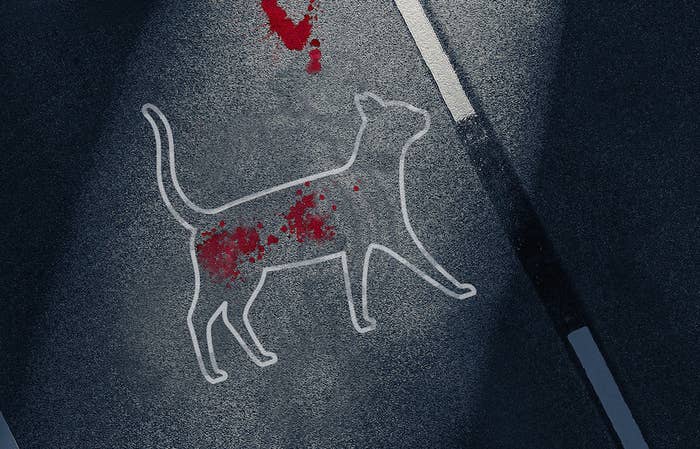
For a while, it appeared that no suburban pet was safe. From modest beginnings in south London, the so-called Croydon Cat Killer came to be blamed for hundreds of cat deaths across the UK.
According to media reports, and to an obscure south London animal rights charity, the deaths spread across the southeast of England to the Midlands and beyond. Even rabbits weren’t safe.
The police took the claims seriously and dedicated an investigation with as many as 15 officers to testing the theory that a single serial killer was murdering and mutilating cats with a bladed weapon. As the number of dead cats continued to rise, the police hunt became national and international news.
But there is only one problem with the serial killer theory: According to the police, it is not true.
On Thursday, the Metropolitan Police announced that after almost three years of investigating more than 400 cases, six of them deemed to be suspicious, there was never any cat killer.
Today’s @EveningStandard: long running police investigation into the ‘Croydon cat killer’ concludes the culprit was a fox ... & Macron leads EU in putting pressure on May https://t.co/aUBphp1jca
“There was no evidence that any of the cats had been killed by a human, however media reports of a ‘Croydon Cat Killer’ or an ‘M25 Cat Killer’ led to widespread public concern about cats being harmed and subsequently many more allegations were received,” the Met’s statement said.
Within minutes, foxes were being shamed across social media and one newspaper front page as the real culprits, forcing the Met to issue a tweet spelling out that cats were in fact “killed due to major blunt force trauma consistent with vehicle collisions”. The foxes had merely mutilated the dead bodies, the tweet said.
To the frustration of local activists and cat lovers who continue to hunt for the supposed killer, as far as the police are concerned, the case is now officially closed.
So how did this tale — for which no credible, incontrovertible evidence was ever released — grow to become a national story? Where did the cat killer myth come from?

The case first came to public attention in October 2015, when the Daily Mail reported that “POLICE are hunting a cat killer who is believed to have used a machete to dismember up to 20 pets and even to have kept body parts as trophies”.
Under the headline “20 CATS BUTCHERED”, the article quoted a pet owner in Croydon, south London, who claimed that his cat, Amber, had its head and tail chopped off.
Also quoted in the article was the uniquely named Boudicca Rising, a cat lover, animal rights activist, and founder of the South Norwood Animal Rescue and Liberty centre, or SNARL.
This, she told the paper, was only one part of a bigger problem that had been ongoing for at least two years: Someone was butchering these cats with a machete.

“That is the only thing that would have had the force to go through with such a clean cut. It is all getting a little bit creepy. It is horrible what this person is doing,” she said.
“It is a terrible level of violence. Amber had wounds that matched some of the other cats found over the past two years and one in particular that seems to be a signature of this person.”
Similar reports also appeared in the Guardian, Metro, Daily Express, Daily Mirror, Evening Standard, and the Croydon Guardian.
Establishing a pattern that would become familiar, each report quoted Rising and her belief that the deaths were the work of a single killer. This allowed reporters and editors to distance themselves from the unlikely scenario that a serial cat killer was on the loose, by presenting this as the view of a local animal welfare activist.

SNARL, a seven-person operation run from Rising’s home, was set up in 2014. It currently houses 12 cats. Yet this tiny operation was in large part responsible for popularising the cat killer story and for pressuring the authorities in action.
A steady stream of similar stories followed, some originating from the SNARL Facebook page, which became and remains a clearinghouse for unusual pet deaths across London and other parts of England.
In November 2015, the pressure grew too much and Scotland Yard announced it was launching an operation, code-named Operation Takahe, into the cat deaths.
In December 2015, the Independent upped the ante by reporting Rising’s fear that the killer may graduate from killing animals to killing people, a story that would occasionally resurface in the next three years as it approached the level of a moral panic.
“All the serial killers of humans that have been studied started by killing animals. Potentially, this is someone who will start attacking vulnerable humans,” she said, imploring the authorities to do something to catch the person responsible.
A criminologist at Birmingham City University, reflecting the genuine fears felt by many cat owners, wrote: “It could be argued here that the individual responsible is not only targeting pets, but also their owners by making them stare at the horrors that they created. By making them pay attention to their actions, this individual is ultimately shattering the very values that comprise suburban and domestic life.”
Later, two years into the police investigation in November 2017, Sergeant Andy Collin told Sky News: “There is a known link between serial killers and harming animals when you look into their dark history.
“If you look at offending patterns, the assumption is this killer is getting some form of gratification. The concern is they will cease getting that gratification and escalate the attacks to humans, specifically vulnerable women and girls.”
At no point had the police found any evidence that any person was behind these deaths — yet a senior officer was still prepared to speculate that the supposed killer might turn his or her attention to vulnerable girls.

By July 2016, the Croydon Cat Killer became the M25 Cat Killer, referring to the orbital ring road that surrounds London, after cat deaths in Surrey and Kent. Then reports emerged from Coventry, Brighton, and Brackley.
Animal rights group PETA was by this point offering a £5,000 reward, later upped to £10,000, for any information that led to a conviction of the person responsible.
But the police investigation stalled: By February 2016 it emerged that detectives had not yet found any evidence of human involvement. In this time the investigation had taken up well over 1,000 police hours.
Despite those doubts, the fear and concern felt by cat owners was and remains undoubtedly genuine and many followed SNARL’s advice and kept their pets indoors at night. An active community of cat owners began to share any news of cat deaths on social media, in the hope of alerting people or in some helping to find the supposed killer.
Let's not forget that the mythical killer was held responsible not just for cat deaths in London but all across England https://t.co/wAH7ih4gFq
Fast forward to July 2018 and the cat killer story had in the eyes of many gone from questionable to outright false.
Stephen Harris, a retired professor in environmental science at Bristol University and an expert on urban foxes, wrote in the New Scientist that the main reason the police hadn’t caught the cat killer is that there isn’t one.
He compared the panic surrounding the Croydon Cat Killer to a similar outcry surrounding a spate of cat deaths in 1998, which led to the Met launching Operation Obelisk. Harris himself examined several cats and decided they were hit by cars and then mutilated by foxes.
How to explain the missing tails and heads that SNARL and its supporters claim can only be the work of a human with a knife? “We have known for decades that foxes chew the head or tail off carcasses, including dead cats,” Harris wrote in his article.
SNARL have angrily dismissed Harris’s claims, and the group has always claimed its own evidence does show the work of a killer.
Boudicca Rising and her partner, Tony Jenkins, became the subject of several media profiles. The New York Times and Vanity Fair both took interest in the story. Just last week, US weekly magazine Newsweek interviewed the pair, in an article which began: “A killer is stalking the streets of England, taking more lives than Jack the Ripper, Ted Bundy and John Wayne Gacy combined.”
And for SNARL, the fight continues: In a statement released after the Met announced it would close Operation Takahe, the group said on its Facebook page:
“As you can imagine, this morning’s announcement has come as a surprise and we will be taking advice on how to move forward.
“We consider that the evidence we have gathered over the last three years does indicate human involvement and there is expert opinion to back this up. Over the last three years, we have discounted over 1500 incidents as non-human related.”
Under the statement on Facebook there are more than 500 comments, overwhelmingly from supporters who allege that the Met has only closed the investigation because of funding cuts.
Speaking to BuzzFeed News, Rising said the Met’s statement came as a shock and said SNARL was given no prior warning. And for Rising it changes nothing: The group’s fight goes on.
Rising pointed to a case in St Leonards, Sussex, at the start of 2018 where, she claims, a rabbit was beheaded and had its paws removed. This was one of several animal deaths that meet a 25-point checklist that SNARL uses to establish cat killer cases (SNARL prefers the term M25 animal killer, to encompass the geography and modus operandi of the supposed criminal).
The killer, Rising said, stuffing the body through a catflap, before returning to the scene and placing the rabbit’s collar on a raised stone where its ripped-out liver had been. She points to similar cases in Wycombe and Hertfordshire.
“There’s no way a fox has done that. From our point of view that is a person who’s done that.”
The police statement on Thursday suggested that investigators have found no human DNA, no CCTV featuring someone dismembering animals, and no witnesses to such crimes. Regardless of this, Rising still believes the killer is out there.
“I totally get that, but we’ve got CCTV of foxes moving bodies but we don’t have CCTV of a fox biting a cat’s head off. Also, the police’s forensic expert originally said it was a person. We’re not convinced by the evidence and we will continue.”
Does Rising believe the cat killer case has become a moral panic, in which people are irrationally scared of a threat that may not exist?
“I can’t comment on what the press do,” she said, “I can only comment on what we do. We continue to believe that there’s somebody doing this and nothing we’ve seen this morning has shown otherwise.”
CORRECTION
Sergeant Andy Collin’s name was misspelled in an earlier version of this post.
